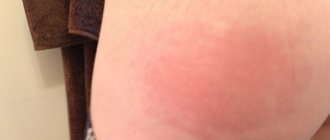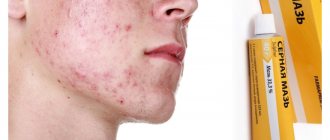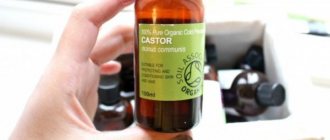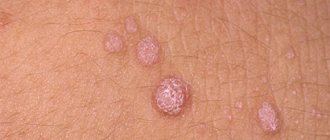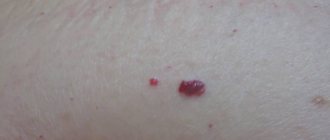The occurrence of papillomas and other skin growths often requires the use of ointments. Hydrocortisone, zinc or oxolinic ointments, Solcoseryl - modern pharmacies offer a variety of remedies. The drug Levomekol for papillomas has good effectiveness and a large number of positive reviews, but before use it is important to find out what indications and contraindications it has.
Is the drug needed or not?
Patients of the dermatovenerologist, using an ointment under the world name “Chloramphenicol + Methyluracil”, receive the expected effect of treating unpleasant papillomas. This is explained by the pharmacological properties of the drug:
- An ointment called "Levomekol" helps against papillomas and warts, condylomas, relieving inflammation from the affected areas of the skin. This is effective in cases of growth of tumors, unsuccessful removal of growths using folk remedies, or after surgery.
At the site of open wounds, scars and frequent friction, warts grow faster, which is why doctors themselves recommend the drug for treatment and prevention.
- Can be used as an antimicrobial agent when it comes to E. coli and staphylococci. This property persists in the presence of purulent discharge, which often accompanies warts, and during necrotic processes.
- The drug stimulates regenerative processes, so the use of levomekol for various types of papillomas receives positive feedback from patients.
The ointment substances work on the principle of inhibiting the protein of pathogenic cells, they stop reproducing. Another advantage is the low ability of bacteria to get used to it. While it is in effect, dehydration of pathogenic cells occurs - and warts and condylomas die off.
What kind of drug is Levomekol?
Levomekol is a drug produced in the form of an ointment and has a wide spectrum of action. This is a safe drug that can be used to treat children and pregnant women if necessary.
The ointment is produced in the form of a yellowish or white medium-thick substance. It is placed in aluminum tubes or glass containers. The therapeutic properties of the drug are determined by its composition. The product is made from:
- chloramphenicol, which has a pronounced antibacterial effect;
- methyluracin, which stimulates tissue regeneration, relieves inflammation and swelling in the area of damage and promotes rapid wound healing.
These are the main active ingredients of the drug. In addition to them, the ointment contains auxiliary components that provide the necessary viscosity and texture, and the ability to quickly penetrate the skin.
Levomekol - a combination drug with an antibiotic
Levomekol ointment for papillomas and other skin defects is used due to the following properties:
- Stop the inflammatory process.
- Destroy pathogenic microorganisms.
- Restore the structure of the skin.
- Accelerate regeneration processes.
- Normalize metabolic processes.
- Penetrate deeply into the epithelium and act at the cellular level.
The popularity of the drug is enhanced by its availability. Depending on the amount of substance in the tube and the manufacturer, the product will cost from 100 to 250 rubles. You can buy it at a pharmacy without a prescription. But, despite this, it is still advisable to consult a specialist about the use of the ointment.
Using ointment
Levomekol cream treats papillomas, purulent wounds, sutures, inflammations, and can also treat burns, ulcers, calluses, spines, cuts, midge bites, etc.
This is an external remedy, but it is applied to tampons if the tumors are located in the rectum or on the female genitalia, and is also used under a sterile bandage.
Features of using ointment on genital warts:
- It is best to apply to clean skin, washed with soap and wiped dry. This way, the product will be absorbed faster. But even in non-sterile conditions the ointment is effective.
- Apply the cream to each wart separately. For this, it is more convenient to use a plastic applicator, since a cotton swab can leave fibers in a possible wound.
- When asked whether it is possible to smear Levomekol on genital papillomas, dermatovenerologists say yes. For 1 - 2 weeks, they are treated twice a day and left to dry. Then they take a break for 3–5 days, and continue treatment again. In general, it lasts about a month.
- If, after trying to remove warts yourself, there are still open or non-healing wounds, you can dip a napkin in the ointment and cover the injury with it.
Levomekol for possible papillomas can be used for no more than 5-6 weeks; before use, carefully read the instructions and take into account the subtleties of therapy.
- Before applying, it is better to soften the skin with a moisturizer and not go beyond the wart.
- In case of contact with mucous membranes, wash with water; in case of accidental ingestion, wash the stomach with water and give activated charcoal to drink.
- When treating the surface, try not to treat an area of skin exceeding 10 cm.
- A tube with a capacity of 40 g will last for a long time, because no more than 0.5 g is allowed per knock; other external means can treat the wart an hour before or after applying the cream.
- Sometimes dermatologists advise initially treating the growth with a disinfectant - chlorhexidine. After drying, use Levomekol.
But the drug is not an antiviral agent; it only stimulates the division of healthy cells and eliminates growths. However, doctors indicate that the ointment indirectly promotes the production of interferon - cells responsible for fighting viral infection.
Methods of application
The ointment is intended for external use. If warts or condylomas are located in the anal or genital area, then gauze swabs soaked in Levomekol are applied to them.
Before applying the cream, the skin area should be washed with soap.
It should be noted other features of the use of the medication, which are indicated in the instructions for use:
- Before starting therapy, problem areas are washed with soap and dried well with a towel. These measures contribute to better penetration of the cream components into the epidermis. If sterility conditions are not observed, the therapeutic effect of the drug worsens.
- With Levomekol, each wart is treated separately. The ointment is applied to the lesions using a plastic applicator, since after using cotton swabs, lint may remain on the problem area.
Can the drug be used to treat ridged growths? Doctors give a positive answer to the question. Pathological elevations are treated 2 times a day for several weeks. After treatment, take a break for 5 days and continue therapy again. The average course of use of Levomekol is a month.
Attempts to tear off warts on your own result in bleeding wounds.
If you try to tear off a wart on your own, bleeding wounds and abrasions may remain on its surface. The condition is dangerous due to secondary infection of the problem area. In order to prevent infection, gauze swabs soaked in ointment are applied to the damaged seal.
Before using the drug, you should also consider other subtleties of therapy:
- Apply moisturizer to the wart before using Levomekol. In this case, there is no need to affect healthy areas of the skin.
- If the drug gets on the mucous membranes, they are washed well under running water. If the medication is accidentally swallowed, it is necessary to cleanse the stomach and take a sorbent, for example, activated carbon.
- During treatment with ointment, it is unacceptable to treat skin areas larger than 10 cm in diameter.
If the drug accidentally gets into the stomach, you need to drink activated charcoal
Precautionary measures
Moisturizing creams should be applied to the affected areas several hours before using Levomekol. For infectious diseases of the epidermis, doctors recommend initially treating problem areas with a Chlorhexidine solution. Only after the liquid has dried, ointment is applied to the skin.
It should be noted that Levomekol is not classified as a drug with an antiviral effect; it only stimulates the division of healthy structures of the epidermis, thereby suppressing the activity of the pathogen. Uninfected tissues produce interferon, which fights infection in the body.
To avoid side effects from therapy, you need to remember a few rules:
- When using for the first time, check the sensitivity of the epidermis to the components of the drug.
Testing is carried out on the bend of the elbow. If after 15 minutes there is no swelling or redness in the test area, then the medicine can be used without the risk of developing allergic reactions. Levomekol is contraindicated during pregnancy. - Do not use Levomekol to treat pregnant women and patients under 18 years of age.
- It is undesirable to use the drug in combination with other ointments that have antimicrobial or anti-inflammatory effects.
The ointment is used to treat children only with the consent of the doctor. Experts motivate the possibility of treating young patients with Levomekol by the fact that the components of the drug are practically not absorbed into the blood.
Analogues in the treatment of education
Among the ointments used instead of Levomekol, there are similar creams. The same ingredients that are included in the popular product are found in its direct analogues - Levomethyl and Netran.
Dermatologists include Levosin, Lingezin, Ichthyol ointment and Vishnevsky ointment as indirect analogues.
They affect growths in different ways:
- Levomethyl duplicates the composition of Levomekol, acts more mildly, and costs less. But the list of Levomethyl ingredients contains Levomekol itself; the dermatologist’s patient receives a “diluted” version of the well-known antibiotic.
- Netran differs only in its commercial name.
- Levosin ointment contains the same active ingredients as Levomekol, only in smaller quantities, as well as sulfadimethoxine and the anesthetic trimecaine. This product has anesthetic and bactericidal properties.
- Using Vishnevsky ointment, patients note positive dynamics in the treatment of external growth, but there are also differences from Levomekol.
Vishnevsky ointment has a specific smell and dark color; it contains birch tar - a homeopathic ingredient. The product is effective for small growths.
Despite slight differences in cost, Levomekol against emerging papillomas is considered the most effective. One of its ingredients, methyluracil, is included in the list of vital medicinal drugs.
Does it help with papillomas?
Can Levomekol get rid of papillomas? This effective remedy is used for almost all skin diseases. Levomekol quickly and effectively relieves bedsores, boils, and warts.
The medicine really helps to get rid of unpleasant papillomas caused by the human papilloma virus in a short time. The effectiveness of the product can be judged by numerous positive reviews from patients. In addition, doctors themselves often recommend buying a drug against papillomas.
Interesting! The medication not only removes warts, but also treats them after getting rid of them with laser and other methods. Levomekol is a superdrug used for the treatment of papillomas and after surgical removal of the growth.
Contraindications and side effects of the drug
Carefully applying the ointment to the head of each wart or condyloma will help avoid an overdose. Care should be taken not to use the product for a long period of time, more than 5 weeks, and not to apply to mucous membranes or healthy skin.
Features of treatment:
- Before application, check the skin for sensitivity to the drug. If redness or swelling occurs at the treatment site, it is better to contact a dermatovenerologist to prescribe another external medicine.
- It is not advisable to use Levomekol for pregnant and nursing mothers, children under adulthood (under 18 years), or simultaneously with other external agents.
The drug, at the discretion of the doctor, can be prescribed to a small child and pregnant women, citing the fact that it is external and is poorly absorbed.
However, studies have confirmed that the antibiotic Chloramphenicol included in the composition is toxic in large doses and internal administration. When treating warts with it, the risk of developing aplastic anemia still arises, albeit in infrequent cases.
- It is better not to apply Levomekol ointment for growths and papillomas, as doctors' reviews indicate, to the skin in the spine area - to avoid affecting the bone marrow.
But not only ointments will help you get rid of growths completely. It is necessary to take antiviral drugs and improve your diet. Vitamins of groups B, C and A must be present in the daily menu.
How to treat wounds after removal of papillomas?
Photo of brilliant green for treating wounds after removal of papillomas
As a rule, with a gentle method of destruction of papillomas, for example, with a laser or radio knife, the wound does not require the use of special care products. The area of damage is usually minimal in size and depth, which means it can be easily and quickly restored naturally.
Before choosing how to treat a wound after papilloma removal with a laser or any other method, it is worth remembering that the list of recommended products depends on the individual characteristics of the patient, the condition of his skin, and the location of the tumor. In most cases, doctors prescribe antiseptic and anti-inflammatory agents.
In the first few days after removing the growth, topical disinfectants should be used. These can be solutions of “brilliant green” (from 14 rubles), iodine (from 11 rubles) or their analogs “potassium permanganate” and alcohol. They should lubricate the edges of the wound.
Antiseptics should be used to treat wounds after removal of papillomas 2-3 times daily. The duration of such medicinal care is determined by a specialist, taking into account the affected area and the depth of penetration of the tumor.
If the papilloma was removed using the “classical” method using a scalpel, then more careful care of the damaged area is required. Usually, the application of sterile dressings soaked in Chlorhexidine (from 9 rubles) or its analogue, Miramistin, is prescribed.
After the scab comes off from the surface of the wound, it is recommended to use special anti-inflammatory restorative ointments . They will help speed up the process of tissue regeneration, reduce the risk of scar formation and pigmentation.
The photo shows an ointment for treating wounds after removing papillomas
Contraindications for the drug
Instructions, indications, contraindications for the use of each medical product are a product of laboratory research. The practical side may vary. But in the case of this drug, the treatment is effective.
Dermatologists themselves can prescribe Levomekol for papillomas of different sizes; reviews from doctors and patients are mostly positive, but there are nuances.
- The product should be applied to skin moistened with cream to make warts more sensitive to the drug.
- It is often prescribed after surgical removal or cryodestruction so that damaged skin heals faster and new growths do not form.
- In the case of large formations, Levomekol ointment may not get rid of papillomas, like other external remedies.
If warts appear on the face, eyelids, neck, mouth, back, abdomen or limbs, or in the genital area, it is better to immediately consult a doctor to exclude the possibility of serious pathologies. External remedies only combat the aesthetic problem, but do not solve it.
How does the skin restoration process occur after papillomas are removed?
Regardless of how the tumor was removed, an open wound forms at the site of destruction. As a rule, it has a funnel shape. The depth and size of the damage depends on the method of removing the growth, as well as on its diameter and the depth of penetration into the dermis.
If the size of the papilloma was impressive, then the depth of the wound can reach the papillary layer of the epidermis. This means that the process of tissue restoration will be lengthy, and there is a high risk of scar formation even with proper care and treatment of the wound after removal of the papilloma.
After this, the wound is covered with a protective dense crust of dried lymph and blood products. This crust is a natural “bandage” for damage, which protects it from contamination, mechanical damage, and microorganisms.
For a scab to form, free access of oxygen to the surface of the wound is necessary. Therefore, you cannot cover the damaged area when treating the wound after removing the papilloma with an adhesive plaster for a long time. Oxygen dries out the protruding lymph and blood, and a dense crust forms.
The scab on the wound remains for about a month and should fall off on its own when the damage is completely healed. New epidermal cells form under the crust. Over time, young pink skin forms under the scab. In the first days, it stands out significantly against the background of the rest of the skin. But during the regeneration process, the shade at the site of removal of the growth merges with the healthy epidermis.
Thus, wound healing after removal of papillomas with a laser or any other method occurs within 3-4 weeks. However, this process is individual for each patient and its duration depends on the general state of the immune system, the regenerative abilities of the skin, the location of the damage and its depth.
Reviews from doctors
Elena Viktorovna, Moscow, 35 years old, gynecologist: For patients after removal of condylomas in the intimate area, I recommend treating the site of papilloma removal with hydrogen peroxide and Levomekol ointment - for speedy tissue restoration.
Sergey Vladimirovich, Kirov, 40 years old, pediatrician: If small warts appear in children after 3 years of age, I advise mothers to strengthen the child’s immunity and apply Levomekol, does it help against papillomas? In combination with antiviral drugs for oral administration - yes, but the ointment is not able to ensure 100% recovery.
Complications after removal of papillomas
In the photo Levomekol for treating wounds after removal of papillomas
The main complication after removal of a benign skin tumor may be wound infection . As a rule, purulent inflammation is accompanied by increased temperature (local and general), pain, swelling, redness, and pulsation in the wound. This indicates that infection has occurred with staphylococcus or Pseudomonas aeruginosa.
If the doctor suspects bacterial inflammation, the first thing he will do is open the wound and clean it of pus. For this purpose, medications such as Furacilin solution
or its analogue - hydrogen peroxide.
In the future, the use of antimicrobial drugs will be required - treatment of wounds after removal of papillomas with Levomekol
(from 25 rubles) or its analogue Tetracycline ointment. After eliminating the symptoms of inflammation, the wound should be treated in the same way as a regular scab.
Scars can also become a complication after the destruction of deep and large papillomas and warts . Preventive measures will help reduce the risk of their formation. They should be used at the stage of wound healing if the patient has a tendency to form keloid scars. To do this, you can use tools such as Contractubex
(from 713 rubles) or its analogues Venitan Forte and Dermofibraze.
How to treat wounds after removal of papillomas - watch the video:
Removing papilloma is only the first stage in the process of getting rid of unwanted tumors. High-quality skin care after the destruction of the growth is important so that no traces remain after the procedure. Self-medication in this case is not recommended. Only a specialist can describe the correct scheme for preventive treatment and treatment of wounds after removal of papillomas in order to avoid consequences and speed up tissue regeneration.
City Dermatovenerologic Dispensary of St. Petersburg
The drug for external use has unique properties. Levomekol for papillomas ranks first among all available ointments against an unpleasant illness. The medicine has long been considered irreplaceable and is available in every pharmacy. The ointment is widely used, also against hemorrhoids, scratches, wounds, boils and other purulent and inflammatory skin problems.
User reviews
Oksana Anatolyevna, Tver, 45 years old: Condylomas appeared on the face a long time ago, but before they were not so noticeable. I didn’t want to go to the doctor, so I bought Levomekol and began applying it twice a day for a month. The result is this: small growths resolved, and large ones began to crust over and partially fall off. Then she went to the clinic - the doctor froze them and prescribed the same ointment. My conclusion is that it is better to immediately contact a specialist to rule out the possibility of cancer or other troubles, and then continue to receive further treatment with what is widely available.
Igor, Vologda, 24 years old: Warts began to appear on the elbow, I just noticed it - I immediately bought Levomekol, began to smear it and patiently waited for it to dry completely - no more than half an hour. Now there are only small spots left, if the warts start again, I will use the ointment again. It’s good that the shelf life is 2 – 3 years.
